Hackshaw v. Shaw: Negligence and Trespasser's Duty of Care Analysis
VerifiedAdded on 2020/02/19
|12
|2469
|66
Report
AI Summary
This report offers a detailed analysis of the case Hackshaw v. Shaw, which revolves around the tort of negligence and the liability of an occupier towards a trespasser. The case examines the duty of care owed by an occupier of a premises and the special obligations towards different types of trespassers. The facts involve a farmer, Shaw, who, after repeated petrol thefts, confronted a suspected thief, Cox, and his companion, Hackshaw, resulting in Hackshaw being shot. The court addressed issues of negligence, contributory negligence, and the foreseeability of harm, ultimately determining the extent of the occupier's liability. The judgment considered the defendant's duty of care, whether a breach occurred, and the plaintiff's potential contributory negligence. The analysis includes critical legal principles like the 'neighbour principle' from Donoghue v. Stevenson, the exceptions to the duty of care, and the application of the Civil Liability Act. The court's findings on negligence and contributory negligence are discussed, along with the importance of considering the degree of danger and the foreseeability of injury when determining an occupier's duty. The report concludes with an overview of the legal principles and implications of the case.
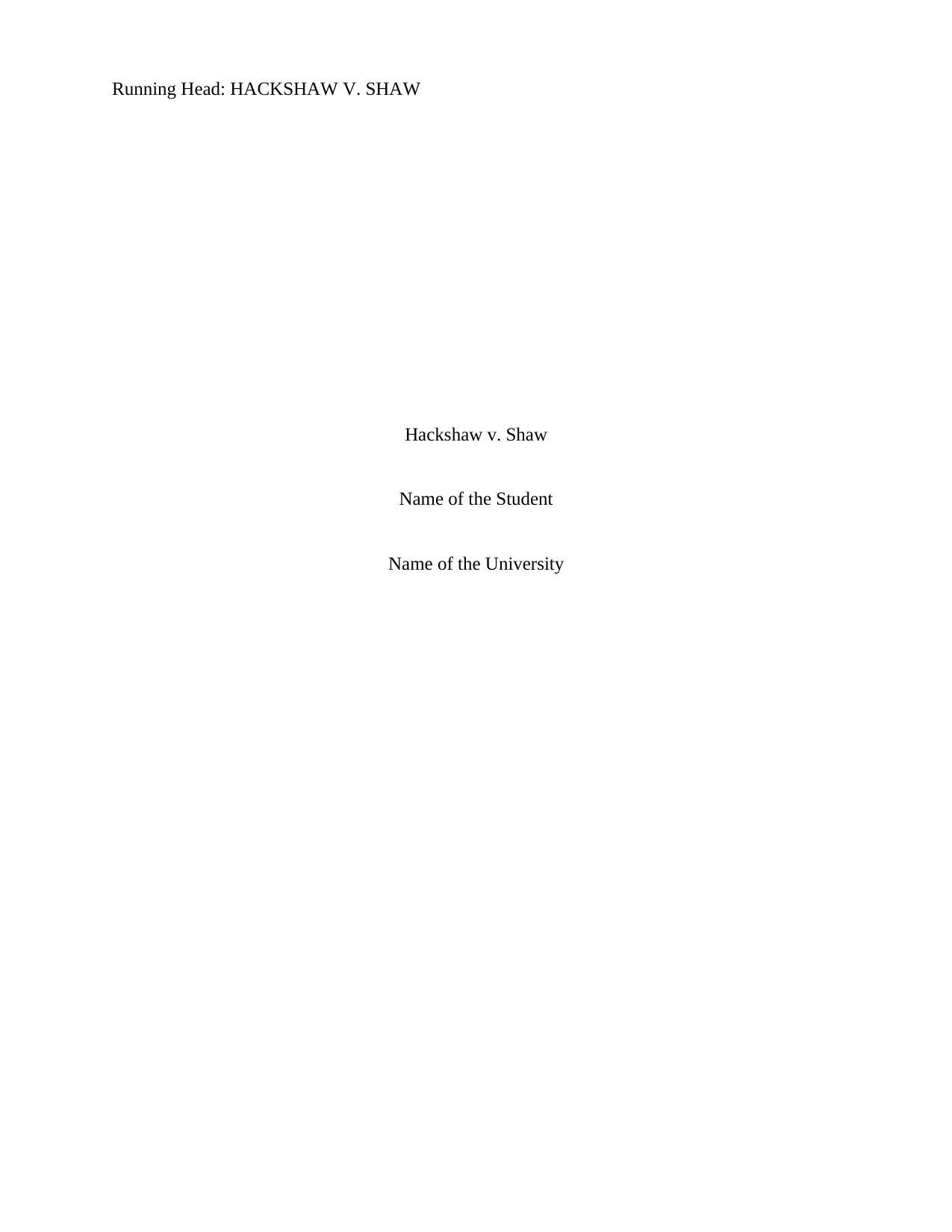
Running Head: HACKSHAW V. SHAW
Hackshaw v. Shaw
Name of the Student
Name of the University
Hackshaw v. Shaw
Name of the Student
Name of the University
Paraphrase This Document
Need a fresh take? Get an instant paraphrase of this document with our AI Paraphraser
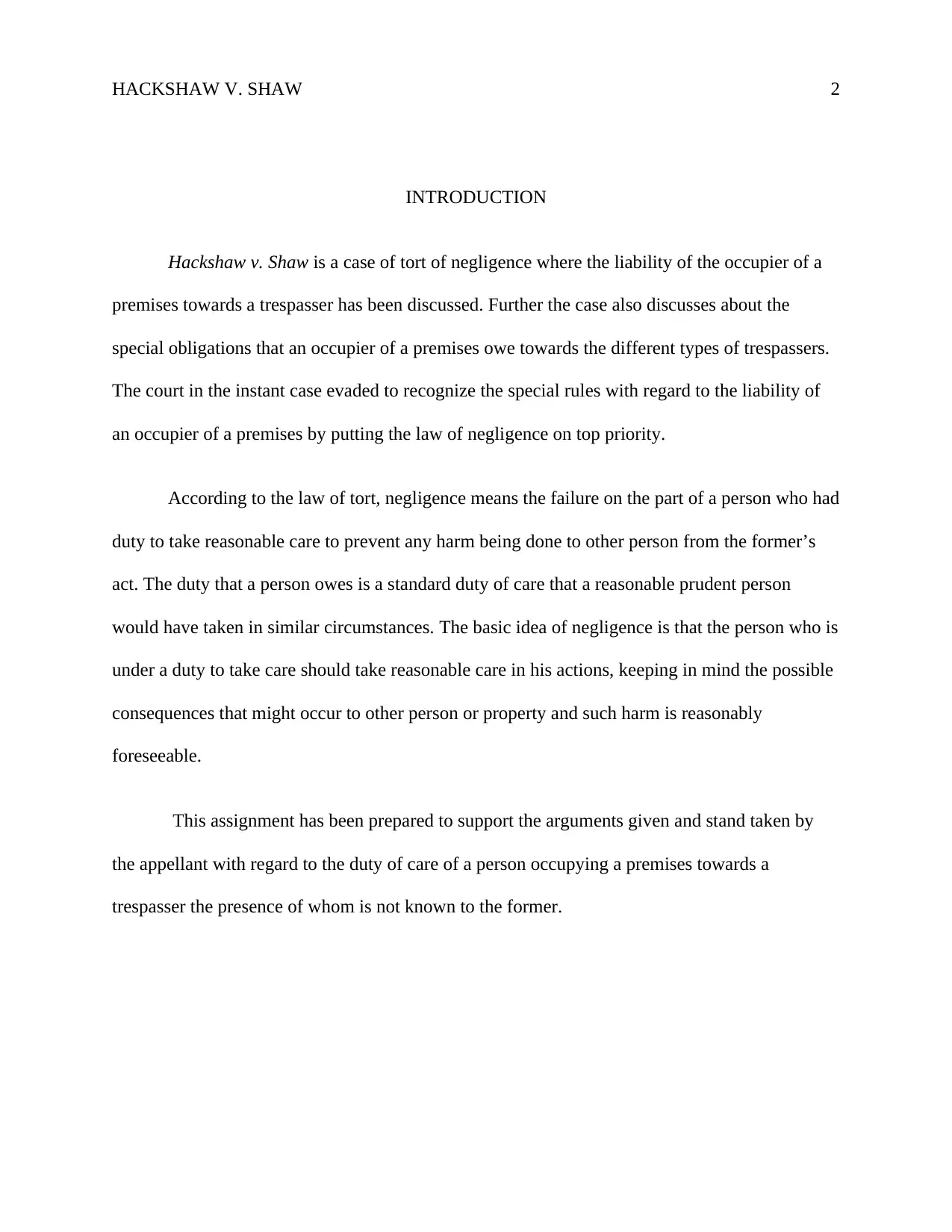
HACKSHAW V. SHAW 2
INTRODUCTION
Hackshaw v. Shaw is a case of tort of negligence where the liability of the occupier of a
premises towards a trespasser has been discussed. Further the case also discusses about the
special obligations that an occupier of a premises owe towards the different types of trespassers.
The court in the instant case evaded to recognize the special rules with regard to the liability of
an occupier of a premises by putting the law of negligence on top priority.
According to the law of tort, negligence means the failure on the part of a person who had
duty to take reasonable care to prevent any harm being done to other person from the former’s
act. The duty that a person owes is a standard duty of care that a reasonable prudent person
would have taken in similar circumstances. The basic idea of negligence is that the person who is
under a duty to take care should take reasonable care in his actions, keeping in mind the possible
consequences that might occur to other person or property and such harm is reasonably
foreseeable.
This assignment has been prepared to support the arguments given and stand taken by
the appellant with regard to the duty of care of a person occupying a premises towards a
trespasser the presence of whom is not known to the former.
INTRODUCTION
Hackshaw v. Shaw is a case of tort of negligence where the liability of the occupier of a
premises towards a trespasser has been discussed. Further the case also discusses about the
special obligations that an occupier of a premises owe towards the different types of trespassers.
The court in the instant case evaded to recognize the special rules with regard to the liability of
an occupier of a premises by putting the law of negligence on top priority.
According to the law of tort, negligence means the failure on the part of a person who had
duty to take reasonable care to prevent any harm being done to other person from the former’s
act. The duty that a person owes is a standard duty of care that a reasonable prudent person
would have taken in similar circumstances. The basic idea of negligence is that the person who is
under a duty to take care should take reasonable care in his actions, keeping in mind the possible
consequences that might occur to other person or property and such harm is reasonably
foreseeable.
This assignment has been prepared to support the arguments given and stand taken by
the appellant with regard to the duty of care of a person occupying a premises towards a
trespasser the presence of whom is not known to the former.
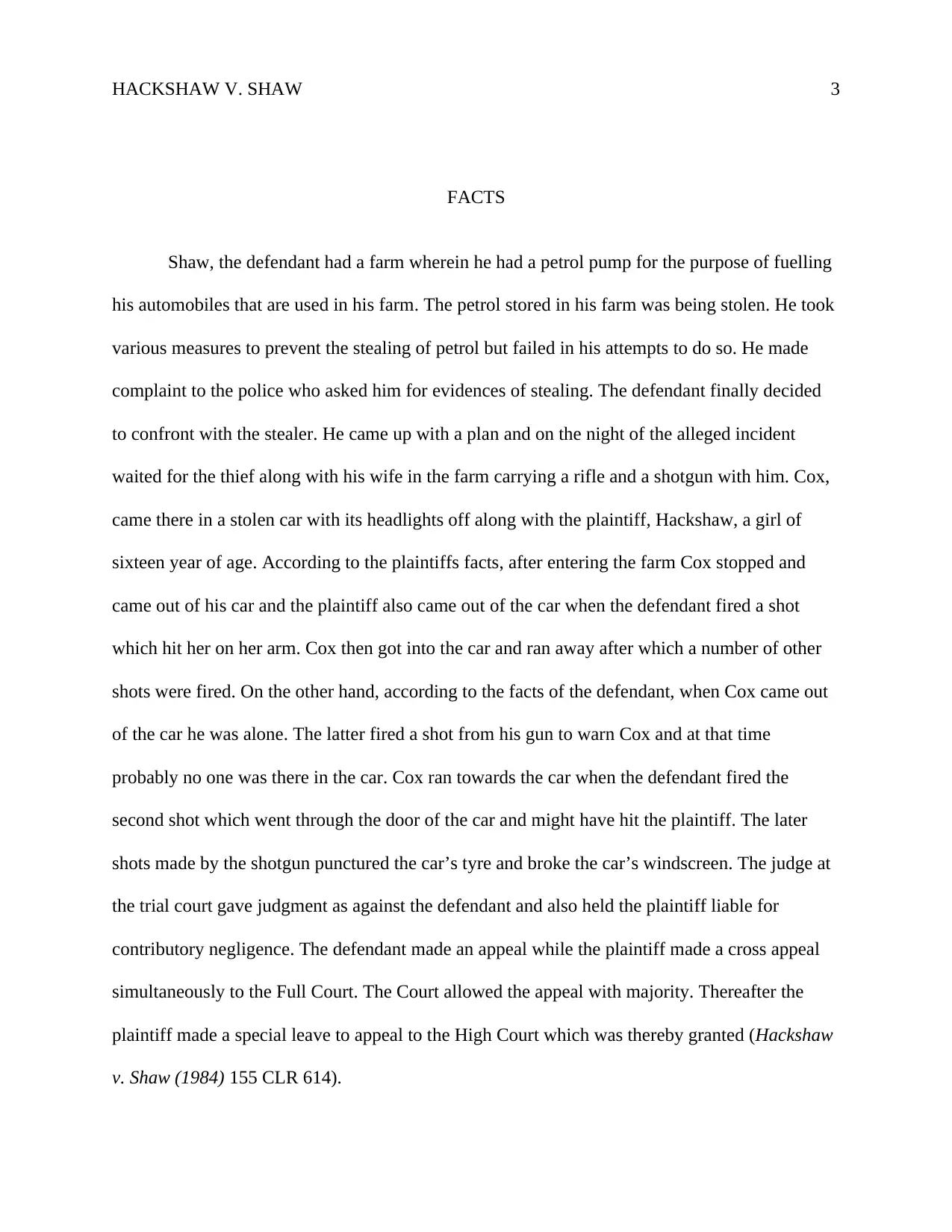
HACKSHAW V. SHAW 3
FACTS
Shaw, the defendant had a farm wherein he had a petrol pump for the purpose of fuelling
his automobiles that are used in his farm. The petrol stored in his farm was being stolen. He took
various measures to prevent the stealing of petrol but failed in his attempts to do so. He made
complaint to the police who asked him for evidences of stealing. The defendant finally decided
to confront with the stealer. He came up with a plan and on the night of the alleged incident
waited for the thief along with his wife in the farm carrying a rifle and a shotgun with him. Cox,
came there in a stolen car with its headlights off along with the plaintiff, Hackshaw, a girl of
sixteen year of age. According to the plaintiffs facts, after entering the farm Cox stopped and
came out of his car and the plaintiff also came out of the car when the defendant fired a shot
which hit her on her arm. Cox then got into the car and ran away after which a number of other
shots were fired. On the other hand, according to the facts of the defendant, when Cox came out
of the car he was alone. The latter fired a shot from his gun to warn Cox and at that time
probably no one was there in the car. Cox ran towards the car when the defendant fired the
second shot which went through the door of the car and might have hit the plaintiff. The later
shots made by the shotgun punctured the car’s tyre and broke the car’s windscreen. The judge at
the trial court gave judgment as against the defendant and also held the plaintiff liable for
contributory negligence. The defendant made an appeal while the plaintiff made a cross appeal
simultaneously to the Full Court. The Court allowed the appeal with majority. Thereafter the
plaintiff made a special leave to appeal to the High Court which was thereby granted (Hackshaw
v. Shaw (1984) 155 CLR 614).
FACTS
Shaw, the defendant had a farm wherein he had a petrol pump for the purpose of fuelling
his automobiles that are used in his farm. The petrol stored in his farm was being stolen. He took
various measures to prevent the stealing of petrol but failed in his attempts to do so. He made
complaint to the police who asked him for evidences of stealing. The defendant finally decided
to confront with the stealer. He came up with a plan and on the night of the alleged incident
waited for the thief along with his wife in the farm carrying a rifle and a shotgun with him. Cox,
came there in a stolen car with its headlights off along with the plaintiff, Hackshaw, a girl of
sixteen year of age. According to the plaintiffs facts, after entering the farm Cox stopped and
came out of his car and the plaintiff also came out of the car when the defendant fired a shot
which hit her on her arm. Cox then got into the car and ran away after which a number of other
shots were fired. On the other hand, according to the facts of the defendant, when Cox came out
of the car he was alone. The latter fired a shot from his gun to warn Cox and at that time
probably no one was there in the car. Cox ran towards the car when the defendant fired the
second shot which went through the door of the car and might have hit the plaintiff. The later
shots made by the shotgun punctured the car’s tyre and broke the car’s windscreen. The judge at
the trial court gave judgment as against the defendant and also held the plaintiff liable for
contributory negligence. The defendant made an appeal while the plaintiff made a cross appeal
simultaneously to the Full Court. The Court allowed the appeal with majority. Thereafter the
plaintiff made a special leave to appeal to the High Court which was thereby granted (Hackshaw
v. Shaw (1984) 155 CLR 614).
⊘ This is a preview!⊘
Do you want full access?
Subscribe today to unlock all pages.

Trusted by 1+ million students worldwide
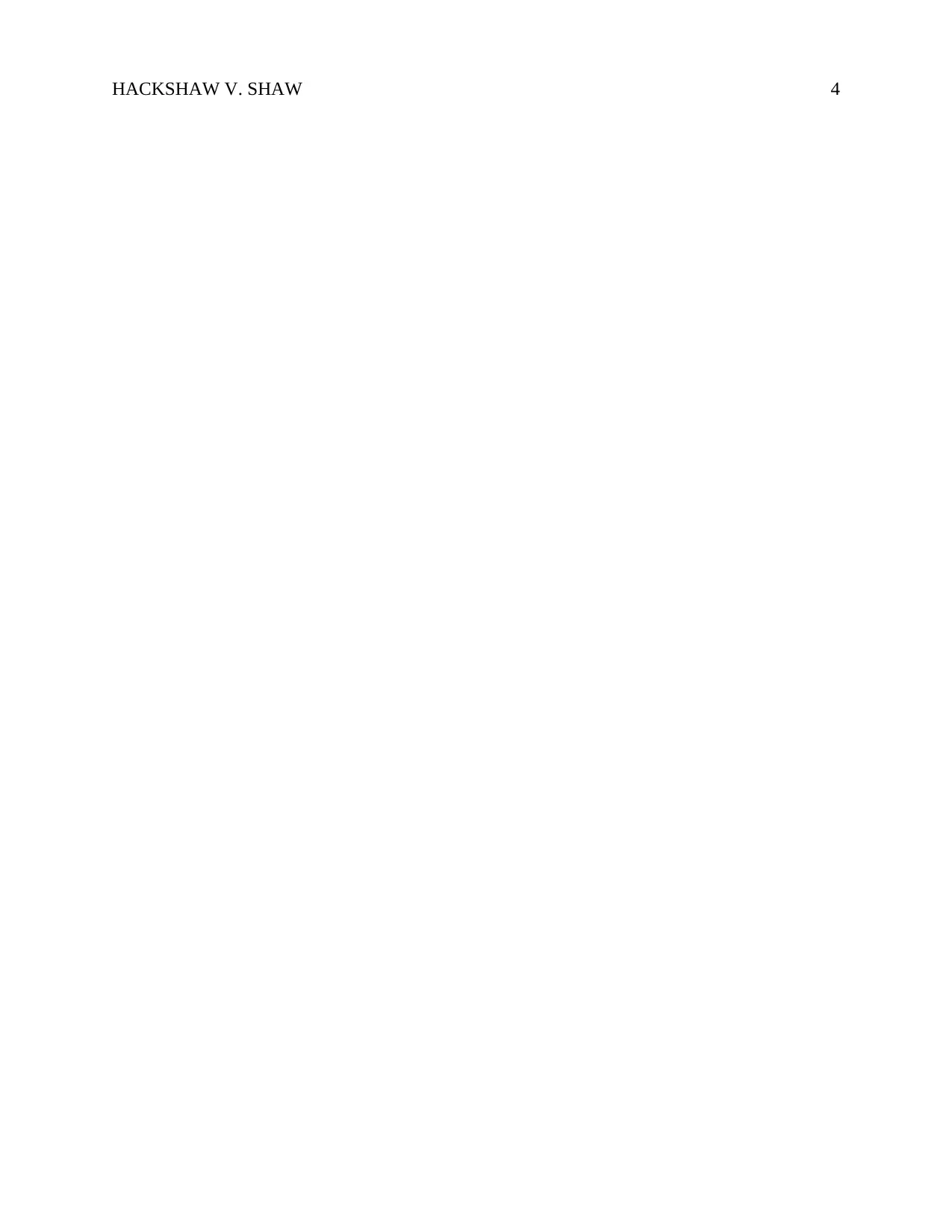
HACKSHAW V. SHAW 4
Paraphrase This Document
Need a fresh take? Get an instant paraphrase of this document with our AI Paraphraser
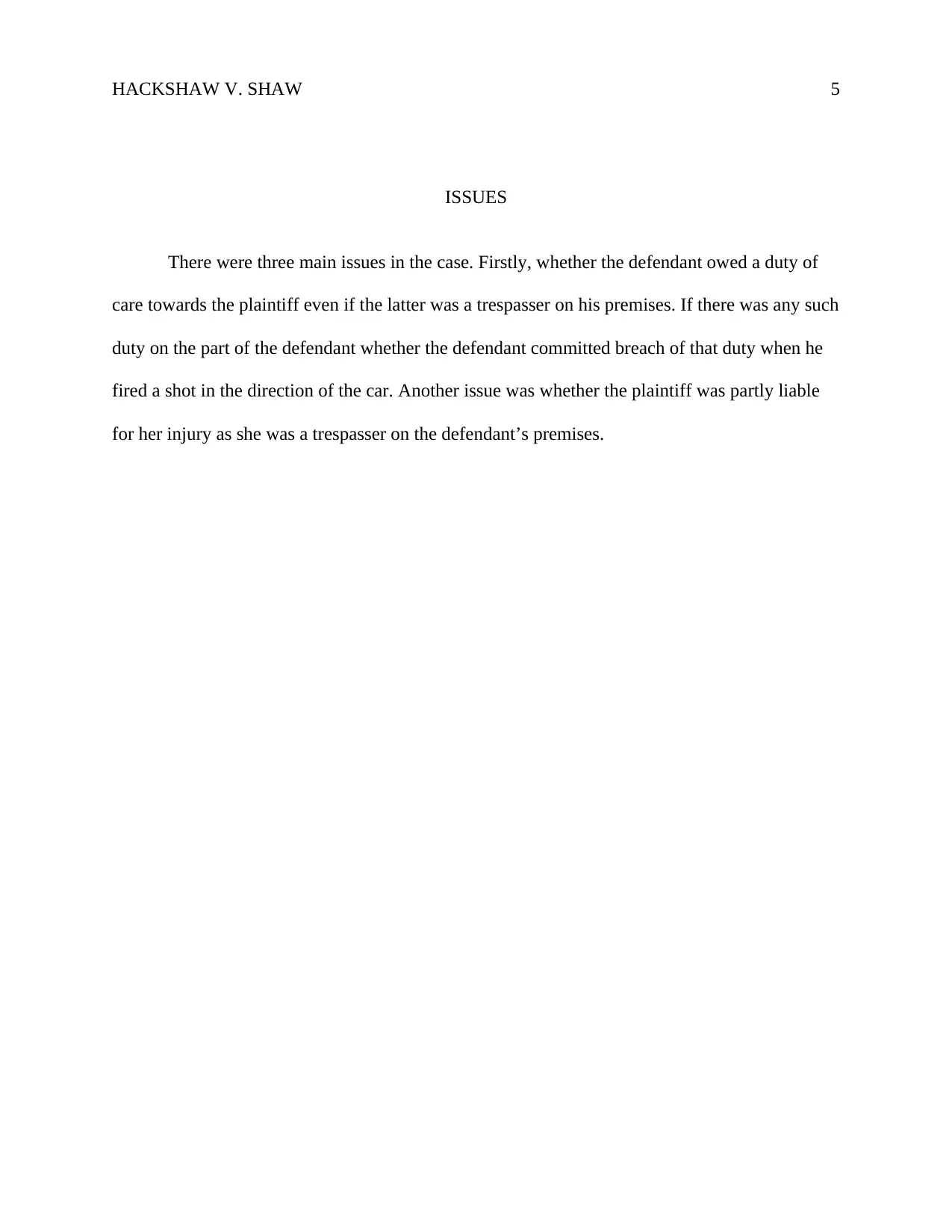
HACKSHAW V. SHAW 5
ISSUES
There were three main issues in the case. Firstly, whether the defendant owed a duty of
care towards the plaintiff even if the latter was a trespasser on his premises. If there was any such
duty on the part of the defendant whether the defendant committed breach of that duty when he
fired a shot in the direction of the car. Another issue was whether the plaintiff was partly liable
for her injury as she was a trespasser on the defendant’s premises.
ISSUES
There were three main issues in the case. Firstly, whether the defendant owed a duty of
care towards the plaintiff even if the latter was a trespasser on his premises. If there was any such
duty on the part of the defendant whether the defendant committed breach of that duty when he
fired a shot in the direction of the car. Another issue was whether the plaintiff was partly liable
for her injury as she was a trespasser on the defendant’s premises.
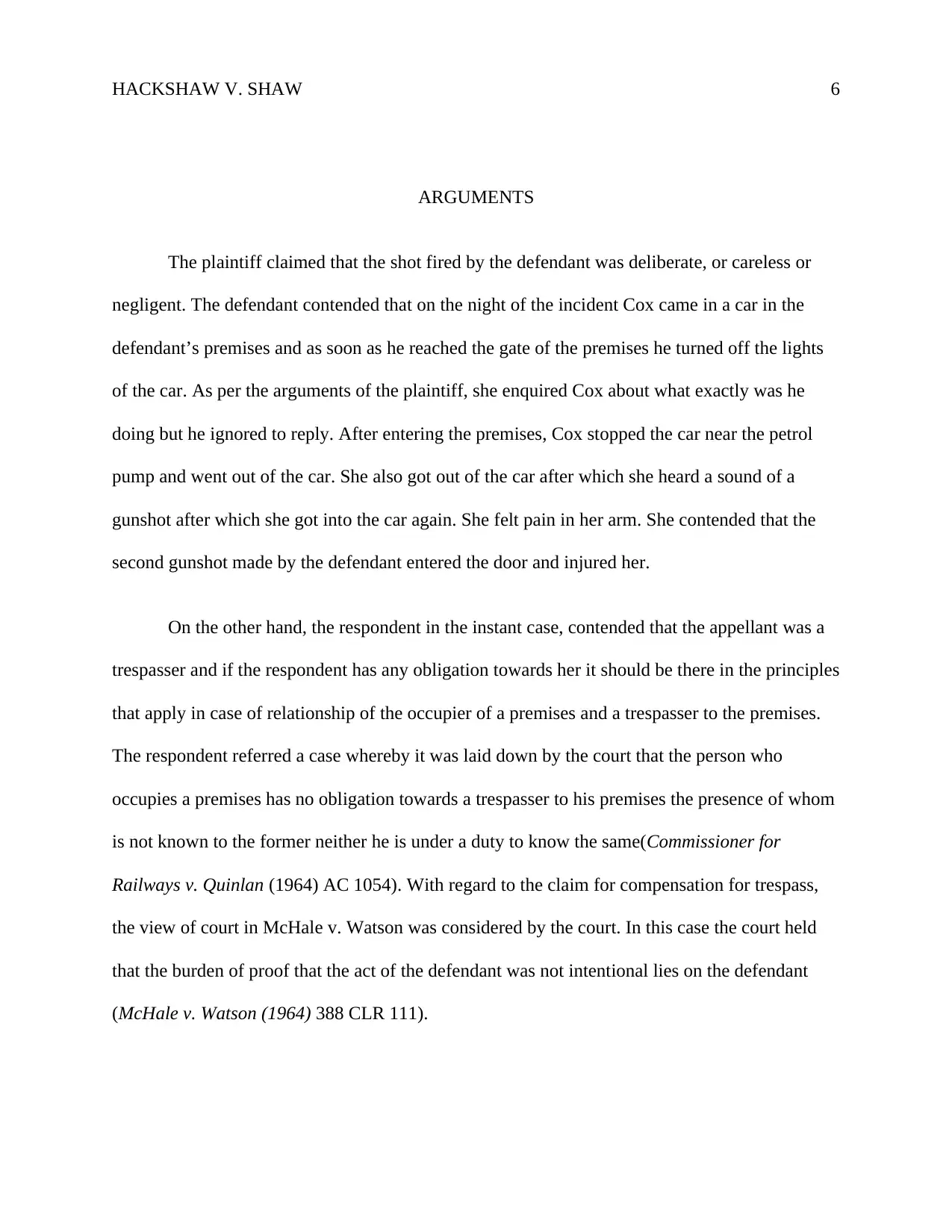
HACKSHAW V. SHAW 6
ARGUMENTS
The plaintiff claimed that the shot fired by the defendant was deliberate, or careless or
negligent. The defendant contended that on the night of the incident Cox came in a car in the
defendant’s premises and as soon as he reached the gate of the premises he turned off the lights
of the car. As per the arguments of the plaintiff, she enquired Cox about what exactly was he
doing but he ignored to reply. After entering the premises, Cox stopped the car near the petrol
pump and went out of the car. She also got out of the car after which she heard a sound of a
gunshot after which she got into the car again. She felt pain in her arm. She contended that the
second gunshot made by the defendant entered the door and injured her.
On the other hand, the respondent in the instant case, contended that the appellant was a
trespasser and if the respondent has any obligation towards her it should be there in the principles
that apply in case of relationship of the occupier of a premises and a trespasser to the premises.
The respondent referred a case whereby it was laid down by the court that the person who
occupies a premises has no obligation towards a trespasser to his premises the presence of whom
is not known to the former neither he is under a duty to know the same(Commissioner for
Railways v. Quinlan (1964) AC 1054). With regard to the claim for compensation for trespass,
the view of court in McHale v. Watson was considered by the court. In this case the court held
that the burden of proof that the act of the defendant was not intentional lies on the defendant
(McHale v. Watson (1964) 388 CLR 111).
ARGUMENTS
The plaintiff claimed that the shot fired by the defendant was deliberate, or careless or
negligent. The defendant contended that on the night of the incident Cox came in a car in the
defendant’s premises and as soon as he reached the gate of the premises he turned off the lights
of the car. As per the arguments of the plaintiff, she enquired Cox about what exactly was he
doing but he ignored to reply. After entering the premises, Cox stopped the car near the petrol
pump and went out of the car. She also got out of the car after which she heard a sound of a
gunshot after which she got into the car again. She felt pain in her arm. She contended that the
second gunshot made by the defendant entered the door and injured her.
On the other hand, the respondent in the instant case, contended that the appellant was a
trespasser and if the respondent has any obligation towards her it should be there in the principles
that apply in case of relationship of the occupier of a premises and a trespasser to the premises.
The respondent referred a case whereby it was laid down by the court that the person who
occupies a premises has no obligation towards a trespasser to his premises the presence of whom
is not known to the former neither he is under a duty to know the same(Commissioner for
Railways v. Quinlan (1964) AC 1054). With regard to the claim for compensation for trespass,
the view of court in McHale v. Watson was considered by the court. In this case the court held
that the burden of proof that the act of the defendant was not intentional lies on the defendant
(McHale v. Watson (1964) 388 CLR 111).
⊘ This is a preview!⊘
Do you want full access?
Subscribe today to unlock all pages.

Trusted by 1+ million students worldwide
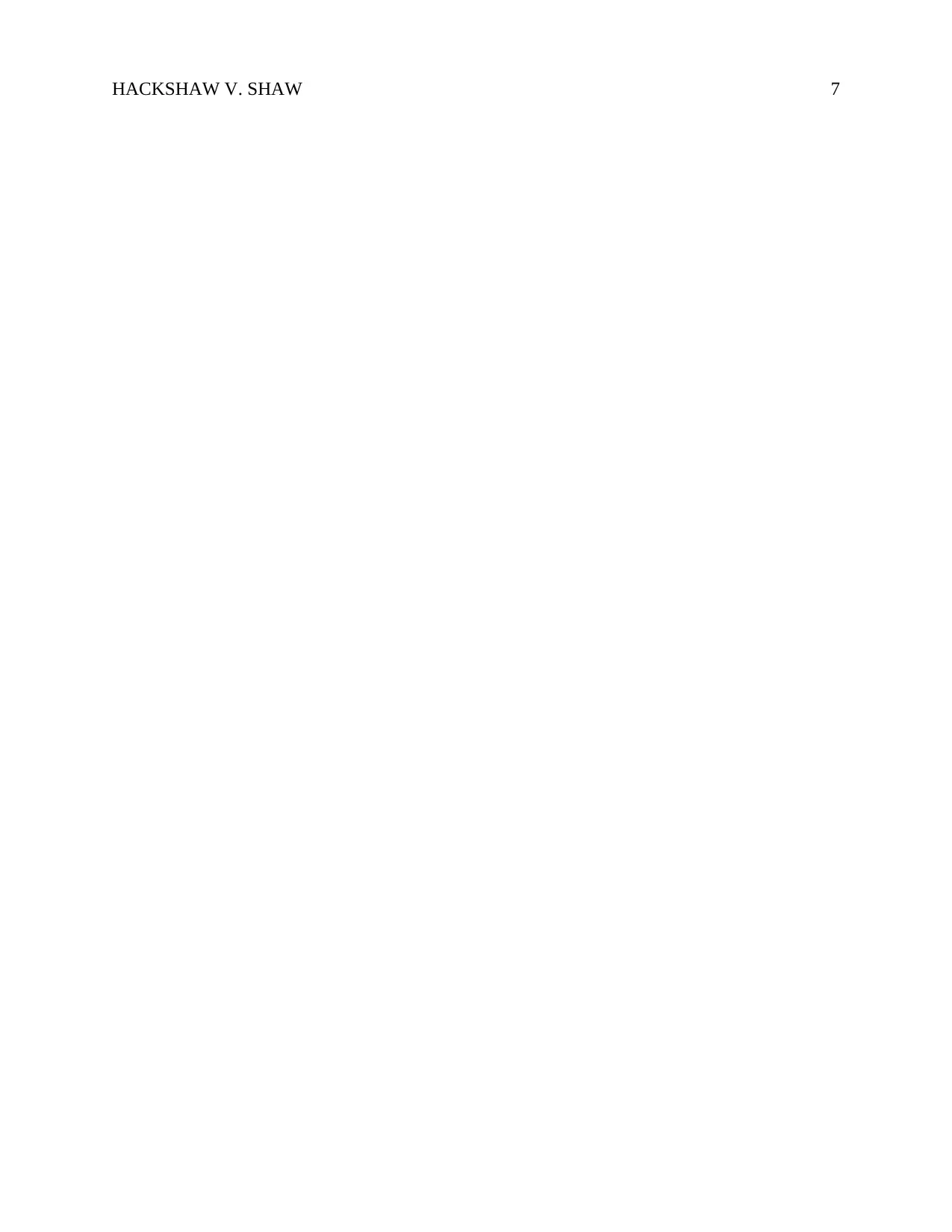
HACKSHAW V. SHAW 7
Paraphrase This Document
Need a fresh take? Get an instant paraphrase of this document with our AI Paraphraser
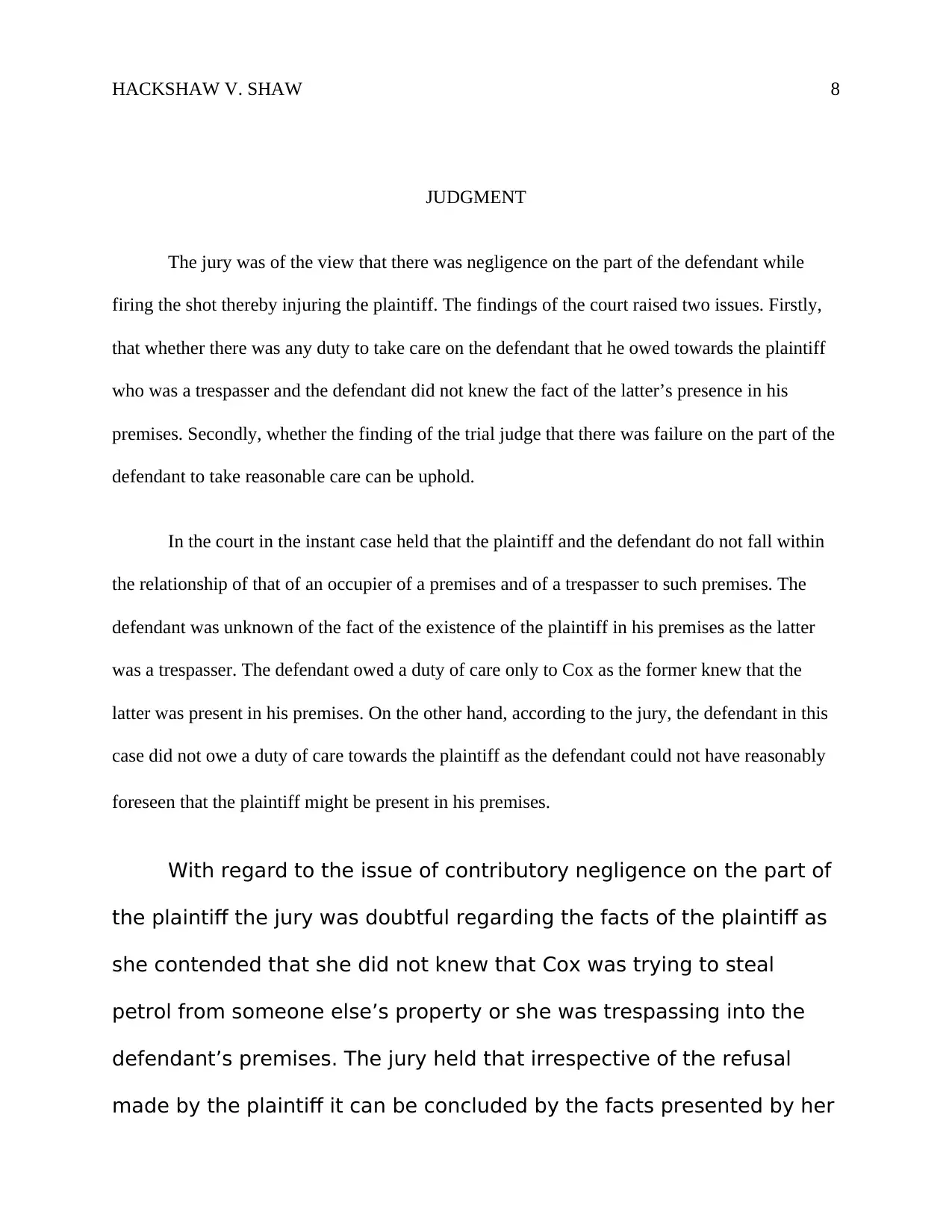
HACKSHAW V. SHAW 8
JUDGMENT
The jury was of the view that there was negligence on the part of the defendant while
firing the shot thereby injuring the plaintiff. The findings of the court raised two issues. Firstly,
that whether there was any duty to take care on the defendant that he owed towards the plaintiff
who was a trespasser and the defendant did not knew the fact of the latter’s presence in his
premises. Secondly, whether the finding of the trial judge that there was failure on the part of the
defendant to take reasonable care can be uphold.
In the court in the instant case held that the plaintiff and the defendant do not fall within
the relationship of that of an occupier of a premises and of a trespasser to such premises. The
defendant was unknown of the fact of the existence of the plaintiff in his premises as the latter
was a trespasser. The defendant owed a duty of care only to Cox as the former knew that the
latter was present in his premises. On the other hand, according to the jury, the defendant in this
case did not owe a duty of care towards the plaintiff as the defendant could not have reasonably
foreseen that the plaintiff might be present in his premises.
With regard to the issue of contributory negligence on the part of
the plaintiff the jury was doubtful regarding the facts of the plaintiff as
she contended that she did not knew that Cox was trying to steal
petrol from someone else’s property or she was trespassing into the
defendant’s premises. The jury held that irrespective of the refusal
made by the plaintiff it can be concluded by the facts presented by her
JUDGMENT
The jury was of the view that there was negligence on the part of the defendant while
firing the shot thereby injuring the plaintiff. The findings of the court raised two issues. Firstly,
that whether there was any duty to take care on the defendant that he owed towards the plaintiff
who was a trespasser and the defendant did not knew the fact of the latter’s presence in his
premises. Secondly, whether the finding of the trial judge that there was failure on the part of the
defendant to take reasonable care can be uphold.
In the court in the instant case held that the plaintiff and the defendant do not fall within
the relationship of that of an occupier of a premises and of a trespasser to such premises. The
defendant was unknown of the fact of the existence of the plaintiff in his premises as the latter
was a trespasser. The defendant owed a duty of care only to Cox as the former knew that the
latter was present in his premises. On the other hand, according to the jury, the defendant in this
case did not owe a duty of care towards the plaintiff as the defendant could not have reasonably
foreseen that the plaintiff might be present in his premises.
With regard to the issue of contributory negligence on the part of
the plaintiff the jury was doubtful regarding the facts of the plaintiff as
she contended that she did not knew that Cox was trying to steal
petrol from someone else’s property or she was trespassing into the
defendant’s premises. The jury held that irrespective of the refusal
made by the plaintiff it can be concluded by the facts presented by her
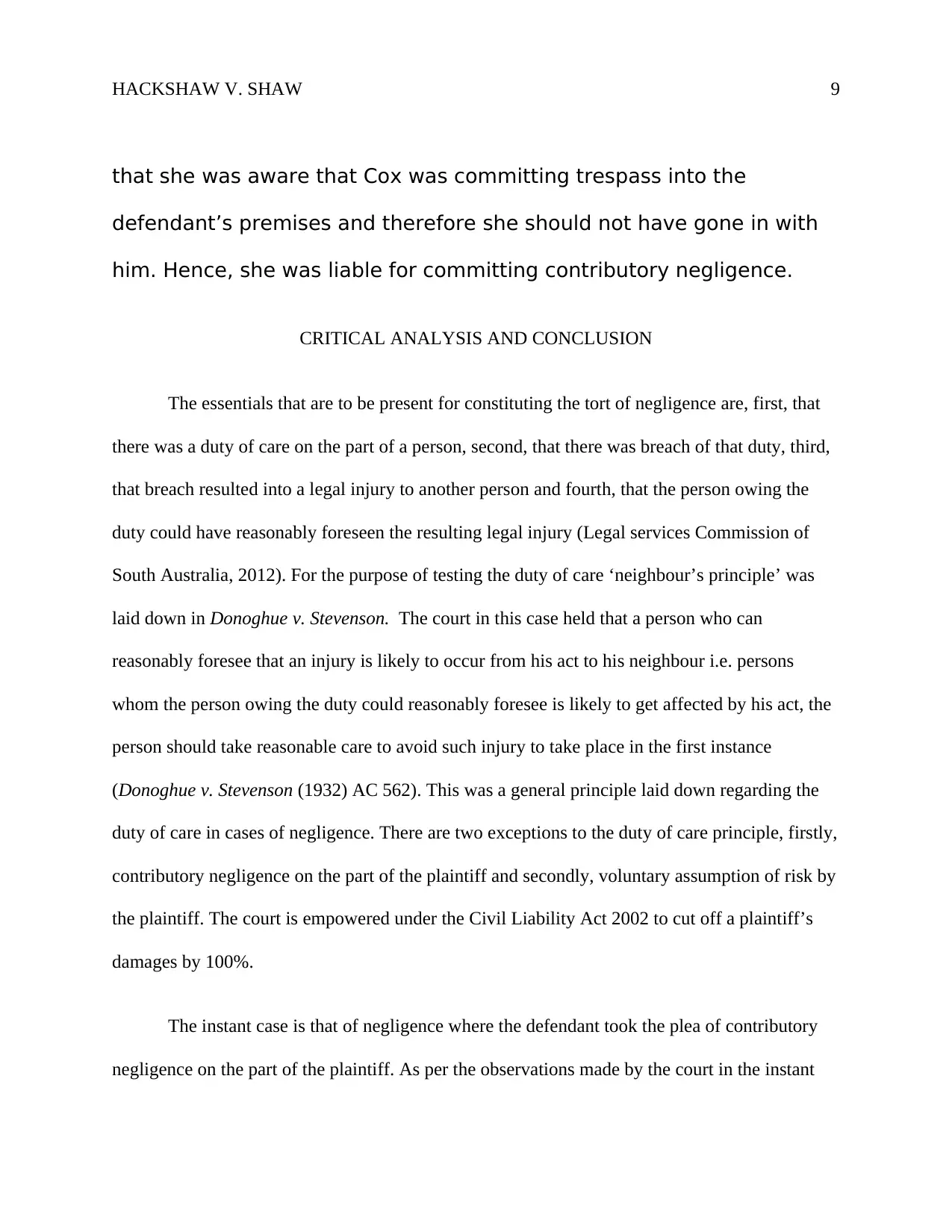
HACKSHAW V. SHAW 9
that she was aware that Cox was committing trespass into the
defendant’s premises and therefore she should not have gone in with
him. Hence, she was liable for committing contributory negligence.
CRITICAL ANALYSIS AND CONCLUSION
The essentials that are to be present for constituting the tort of negligence are, first, that
there was a duty of care on the part of a person, second, that there was breach of that duty, third,
that breach resulted into a legal injury to another person and fourth, that the person owing the
duty could have reasonably foreseen the resulting legal injury (Legal services Commission of
South Australia, 2012). For the purpose of testing the duty of care ‘neighbour’s principle’ was
laid down in Donoghue v. Stevenson. The court in this case held that a person who can
reasonably foresee that an injury is likely to occur from his act to his neighbour i.e. persons
whom the person owing the duty could reasonably foresee is likely to get affected by his act, the
person should take reasonable care to avoid such injury to take place in the first instance
(Donoghue v. Stevenson (1932) AC 562). This was a general principle laid down regarding the
duty of care in cases of negligence. There are two exceptions to the duty of care principle, firstly,
contributory negligence on the part of the plaintiff and secondly, voluntary assumption of risk by
the plaintiff. The court is empowered under the Civil Liability Act 2002 to cut off a plaintiff’s
damages by 100%.
The instant case is that of negligence where the defendant took the plea of contributory
negligence on the part of the plaintiff. As per the observations made by the court in the instant
that she was aware that Cox was committing trespass into the
defendant’s premises and therefore she should not have gone in with
him. Hence, she was liable for committing contributory negligence.
CRITICAL ANALYSIS AND CONCLUSION
The essentials that are to be present for constituting the tort of negligence are, first, that
there was a duty of care on the part of a person, second, that there was breach of that duty, third,
that breach resulted into a legal injury to another person and fourth, that the person owing the
duty could have reasonably foreseen the resulting legal injury (Legal services Commission of
South Australia, 2012). For the purpose of testing the duty of care ‘neighbour’s principle’ was
laid down in Donoghue v. Stevenson. The court in this case held that a person who can
reasonably foresee that an injury is likely to occur from his act to his neighbour i.e. persons
whom the person owing the duty could reasonably foresee is likely to get affected by his act, the
person should take reasonable care to avoid such injury to take place in the first instance
(Donoghue v. Stevenson (1932) AC 562). This was a general principle laid down regarding the
duty of care in cases of negligence. There are two exceptions to the duty of care principle, firstly,
contributory negligence on the part of the plaintiff and secondly, voluntary assumption of risk by
the plaintiff. The court is empowered under the Civil Liability Act 2002 to cut off a plaintiff’s
damages by 100%.
The instant case is that of negligence where the defendant took the plea of contributory
negligence on the part of the plaintiff. As per the observations made by the court in the instant
⊘ This is a preview!⊘
Do you want full access?
Subscribe today to unlock all pages.

Trusted by 1+ million students worldwide
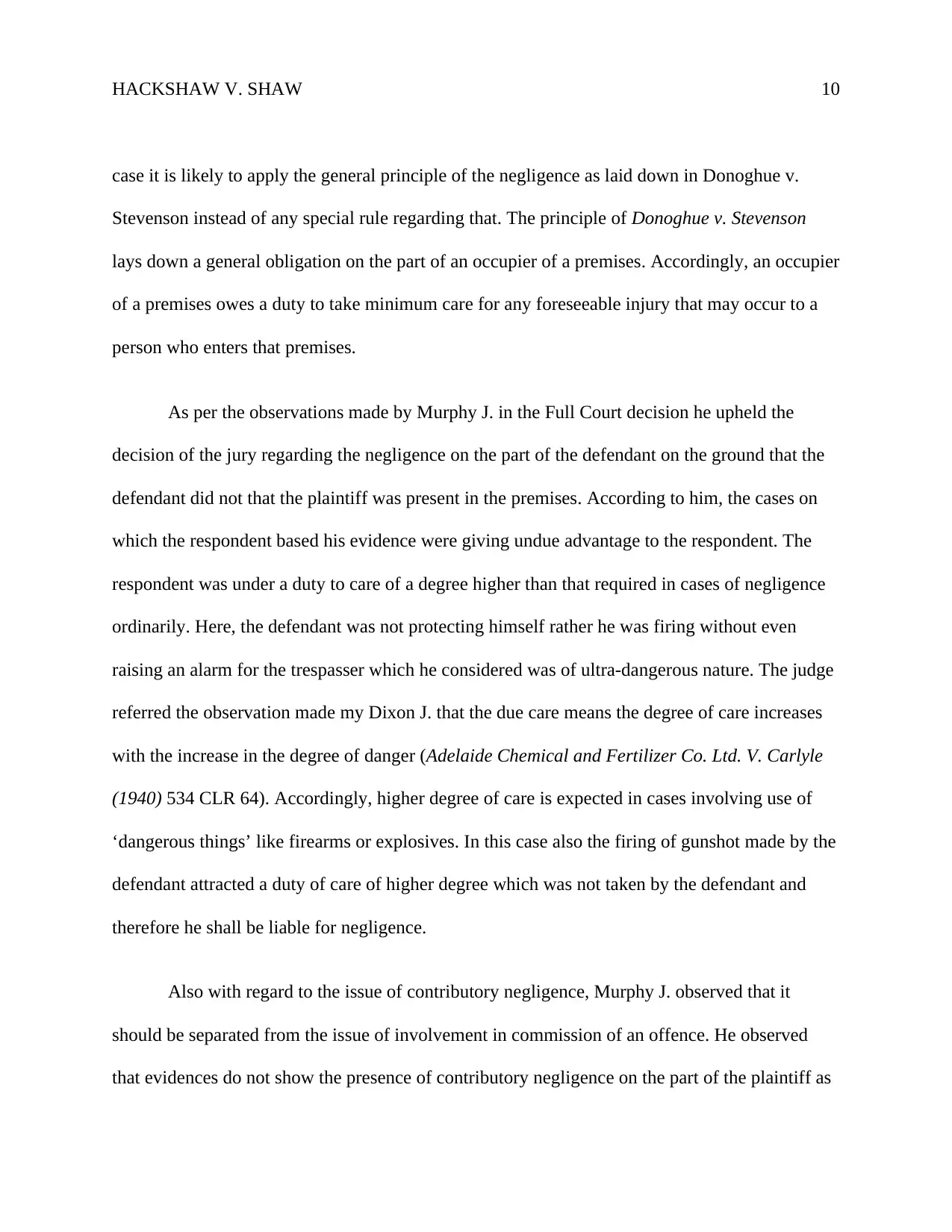
HACKSHAW V. SHAW 10
case it is likely to apply the general principle of the negligence as laid down in Donoghue v.
Stevenson instead of any special rule regarding that. The principle of Donoghue v. Stevenson
lays down a general obligation on the part of an occupier of a premises. Accordingly, an occupier
of a premises owes a duty to take minimum care for any foreseeable injury that may occur to a
person who enters that premises.
As per the observations made by Murphy J. in the Full Court decision he upheld the
decision of the jury regarding the negligence on the part of the defendant on the ground that the
defendant did not that the plaintiff was present in the premises. According to him, the cases on
which the respondent based his evidence were giving undue advantage to the respondent. The
respondent was under a duty to care of a degree higher than that required in cases of negligence
ordinarily. Here, the defendant was not protecting himself rather he was firing without even
raising an alarm for the trespasser which he considered was of ultra-dangerous nature. The judge
referred the observation made my Dixon J. that the due care means the degree of care increases
with the increase in the degree of danger (Adelaide Chemical and Fertilizer Co. Ltd. V. Carlyle
(1940) 534 CLR 64). Accordingly, higher degree of care is expected in cases involving use of
‘dangerous things’ like firearms or explosives. In this case also the firing of gunshot made by the
defendant attracted a duty of care of higher degree which was not taken by the defendant and
therefore he shall be liable for negligence.
Also with regard to the issue of contributory negligence, Murphy J. observed that it
should be separated from the issue of involvement in commission of an offence. He observed
that evidences do not show the presence of contributory negligence on the part of the plaintiff as
case it is likely to apply the general principle of the negligence as laid down in Donoghue v.
Stevenson instead of any special rule regarding that. The principle of Donoghue v. Stevenson
lays down a general obligation on the part of an occupier of a premises. Accordingly, an occupier
of a premises owes a duty to take minimum care for any foreseeable injury that may occur to a
person who enters that premises.
As per the observations made by Murphy J. in the Full Court decision he upheld the
decision of the jury regarding the negligence on the part of the defendant on the ground that the
defendant did not that the plaintiff was present in the premises. According to him, the cases on
which the respondent based his evidence were giving undue advantage to the respondent. The
respondent was under a duty to care of a degree higher than that required in cases of negligence
ordinarily. Here, the defendant was not protecting himself rather he was firing without even
raising an alarm for the trespasser which he considered was of ultra-dangerous nature. The judge
referred the observation made my Dixon J. that the due care means the degree of care increases
with the increase in the degree of danger (Adelaide Chemical and Fertilizer Co. Ltd. V. Carlyle
(1940) 534 CLR 64). Accordingly, higher degree of care is expected in cases involving use of
‘dangerous things’ like firearms or explosives. In this case also the firing of gunshot made by the
defendant attracted a duty of care of higher degree which was not taken by the defendant and
therefore he shall be liable for negligence.
Also with regard to the issue of contributory negligence, Murphy J. observed that it
should be separated from the issue of involvement in commission of an offence. He observed
that evidences do not show the presence of contributory negligence on the part of the plaintiff as
Paraphrase This Document
Need a fresh take? Get an instant paraphrase of this document with our AI Paraphraser
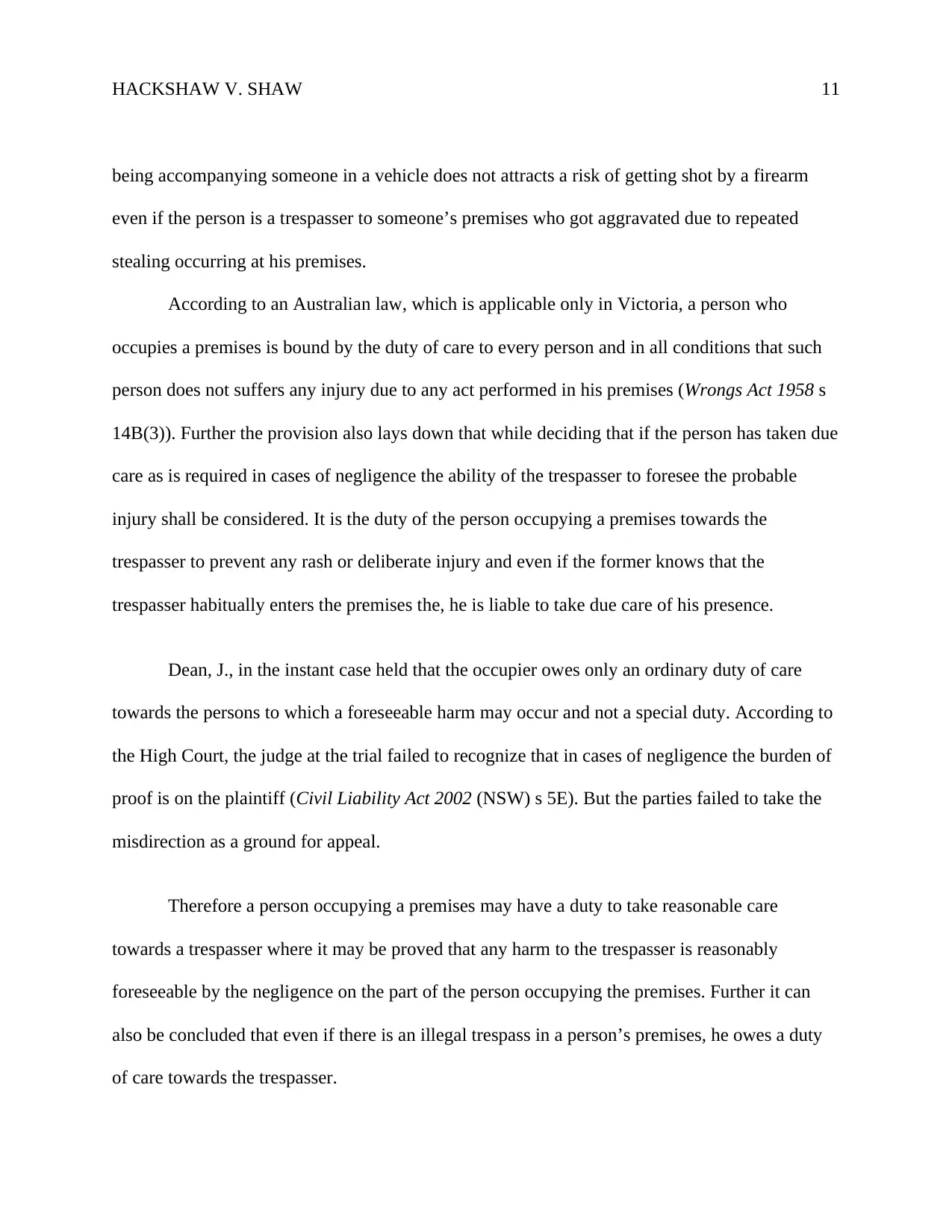
HACKSHAW V. SHAW 11
being accompanying someone in a vehicle does not attracts a risk of getting shot by a firearm
even if the person is a trespasser to someone’s premises who got aggravated due to repeated
stealing occurring at his premises.
According to an Australian law, which is applicable only in Victoria, a person who
occupies a premises is bound by the duty of care to every person and in all conditions that such
person does not suffers any injury due to any act performed in his premises (Wrongs Act 1958 s
14B(3)). Further the provision also lays down that while deciding that if the person has taken due
care as is required in cases of negligence the ability of the trespasser to foresee the probable
injury shall be considered. It is the duty of the person occupying a premises towards the
trespasser to prevent any rash or deliberate injury and even if the former knows that the
trespasser habitually enters the premises the, he is liable to take due care of his presence.
Dean, J., in the instant case held that the occupier owes only an ordinary duty of care
towards the persons to which a foreseeable harm may occur and not a special duty. According to
the High Court, the judge at the trial failed to recognize that in cases of negligence the burden of
proof is on the plaintiff (Civil Liability Act 2002 (NSW) s 5E). But the parties failed to take the
misdirection as a ground for appeal.
Therefore a person occupying a premises may have a duty to take reasonable care
towards a trespasser where it may be proved that any harm to the trespasser is reasonably
foreseeable by the negligence on the part of the person occupying the premises. Further it can
also be concluded that even if there is an illegal trespass in a person’s premises, he owes a duty
of care towards the trespasser.
being accompanying someone in a vehicle does not attracts a risk of getting shot by a firearm
even if the person is a trespasser to someone’s premises who got aggravated due to repeated
stealing occurring at his premises.
According to an Australian law, which is applicable only in Victoria, a person who
occupies a premises is bound by the duty of care to every person and in all conditions that such
person does not suffers any injury due to any act performed in his premises (Wrongs Act 1958 s
14B(3)). Further the provision also lays down that while deciding that if the person has taken due
care as is required in cases of negligence the ability of the trespasser to foresee the probable
injury shall be considered. It is the duty of the person occupying a premises towards the
trespasser to prevent any rash or deliberate injury and even if the former knows that the
trespasser habitually enters the premises the, he is liable to take due care of his presence.
Dean, J., in the instant case held that the occupier owes only an ordinary duty of care
towards the persons to which a foreseeable harm may occur and not a special duty. According to
the High Court, the judge at the trial failed to recognize that in cases of negligence the burden of
proof is on the plaintiff (Civil Liability Act 2002 (NSW) s 5E). But the parties failed to take the
misdirection as a ground for appeal.
Therefore a person occupying a premises may have a duty to take reasonable care
towards a trespasser where it may be proved that any harm to the trespasser is reasonably
foreseeable by the negligence on the part of the person occupying the premises. Further it can
also be concluded that even if there is an illegal trespass in a person’s premises, he owes a duty
of care towards the trespasser.
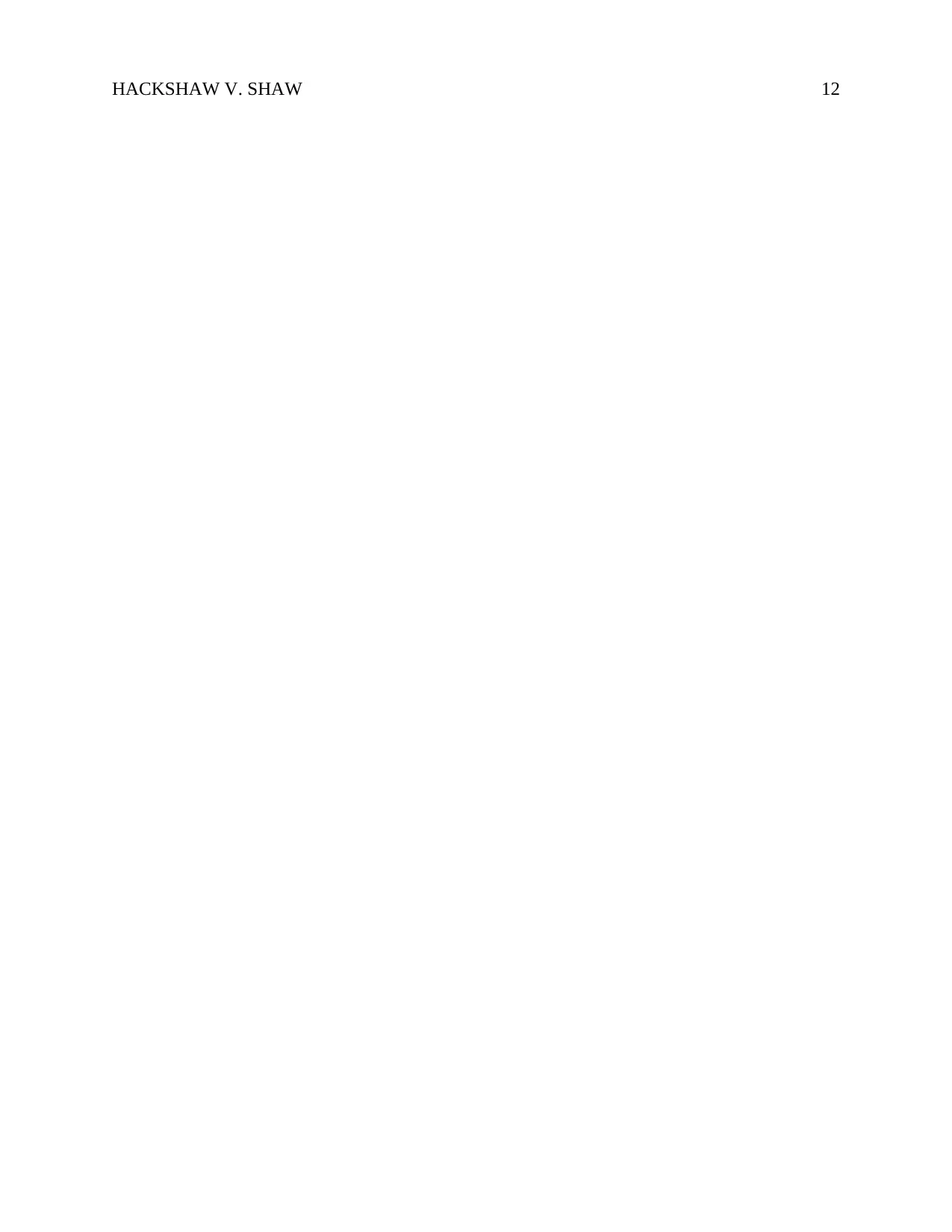
HACKSHAW V. SHAW 12
⊘ This is a preview!⊘
Do you want full access?
Subscribe today to unlock all pages.

Trusted by 1+ million students worldwide
1 out of 12
Related Documents
Your All-in-One AI-Powered Toolkit for Academic Success.
+13062052269
info@desklib.com
Available 24*7 on WhatsApp / Email
![[object Object]](/_next/static/media/star-bottom.7253800d.svg)
Unlock your academic potential
Copyright © 2020–2025 A2Z Services. All Rights Reserved. Developed and managed by ZUCOL.

![Hackshaw v. Shaw [1984] 155 CLR 614: A Detailed Case Analysis](/_next/image/?url=https%3A%2F%2Fdesklib.com%2Fmedia%2Fimages%2Fwz%2F78dce05f3ebb44cf94685032c9503309.jpg&w=256&q=75)



